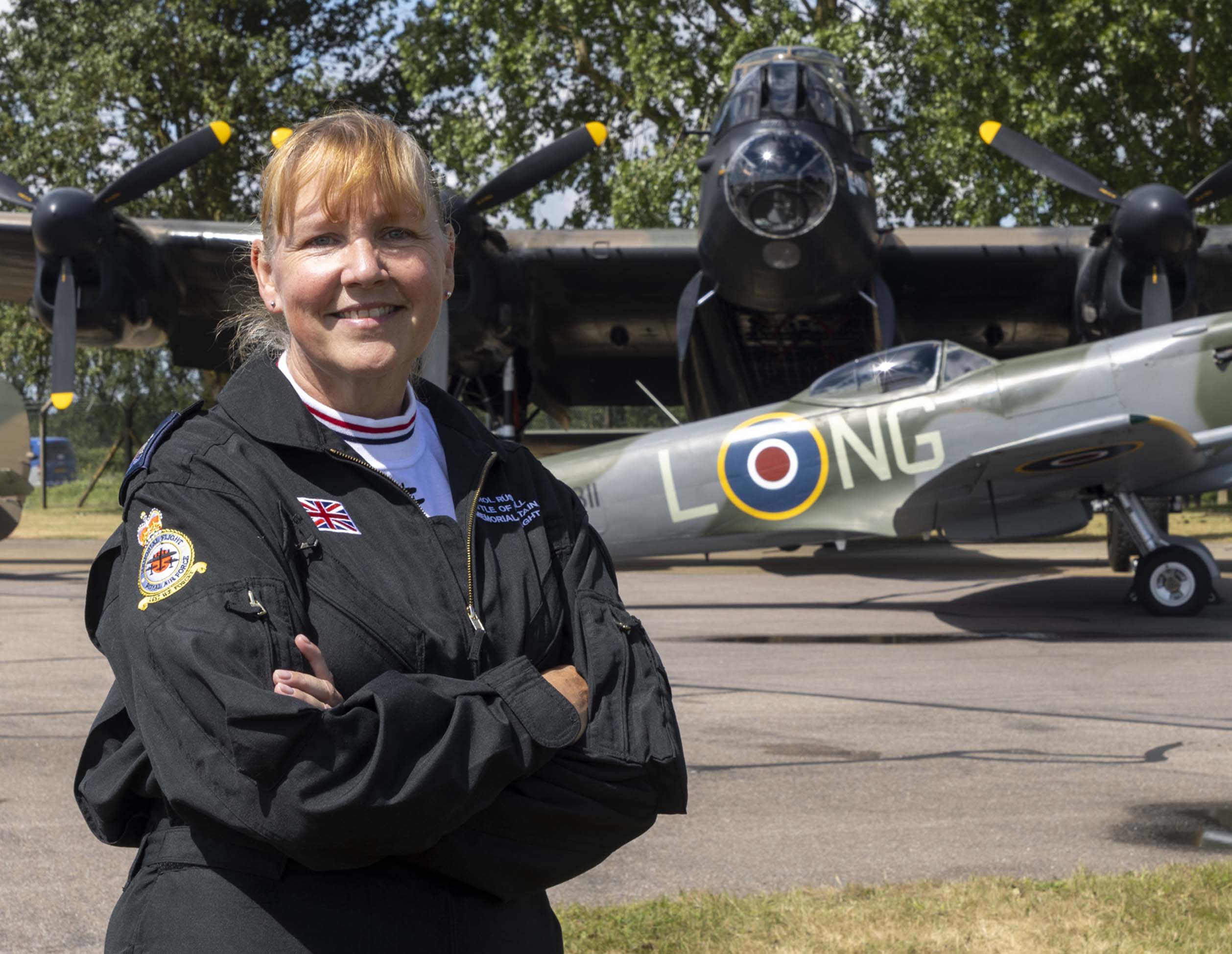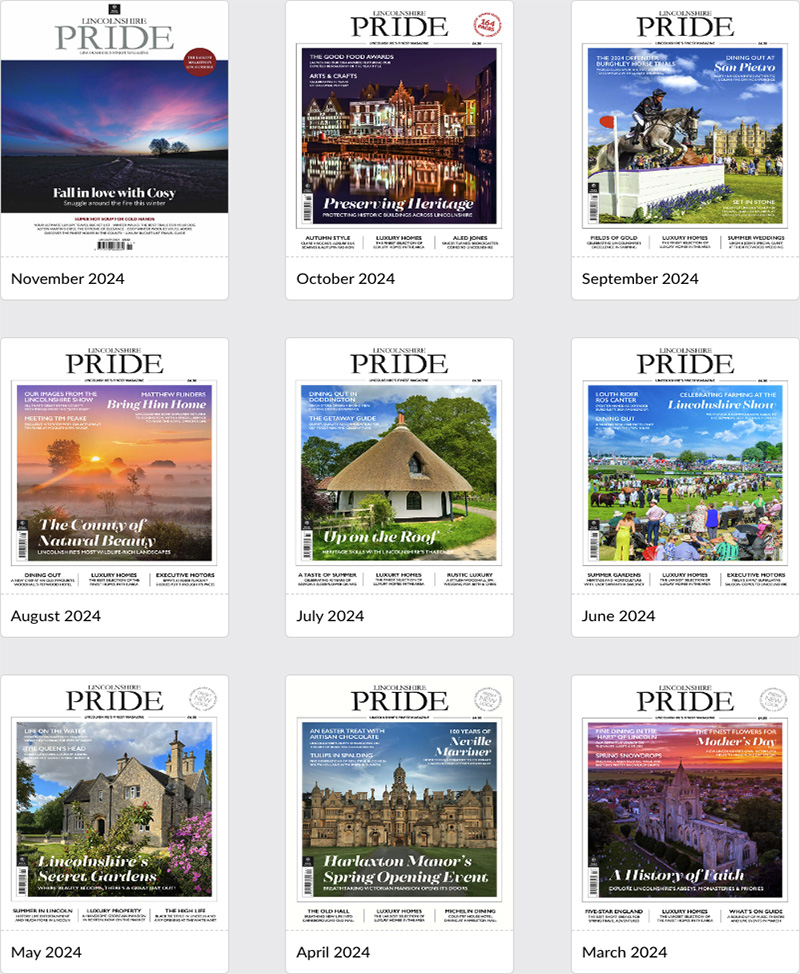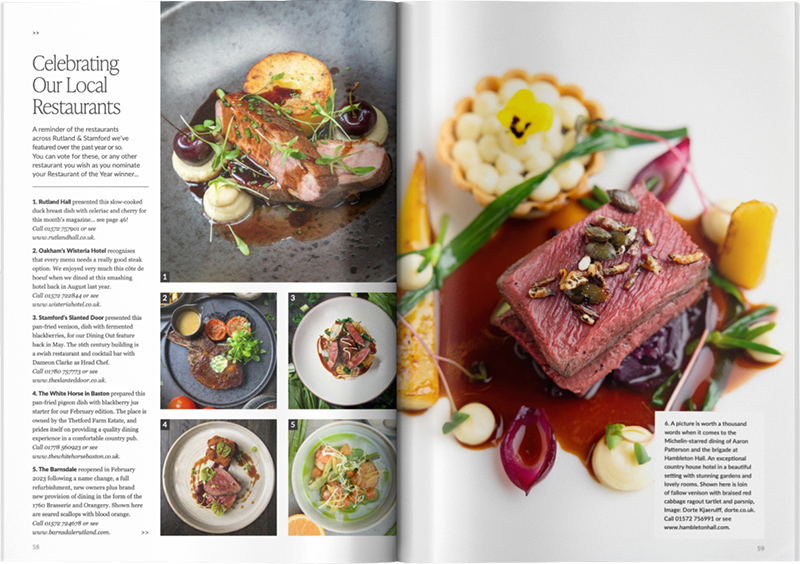
Remembering Our Fallen Heroes
This month we’re meeting three people from across Lincolnshire who are keen to ensure that Lincolnshire remembers those who gave their lives for our freedom
The Battle of Britain Memorial Flight
At RAF Coningsby, the past and the present share the same stretch of tarmac. On one side of the base, ultra-modern Typhoon fighter jets stand on alert, ready to scramble at a moment’s notice as part of the UK’s Quick Reaction Alert force. On the other side, housed in a modest wartime hangar, the Battle of Britain Memorial Flight (BBMF) keeps alive the spirit of the Second World War, flying some of the most iconic aircraft ever built.
For Warrant Officer Carol Russell, who leads the BBMF’s engineering team, it’s a place of pride, passion and deep responsibility. After a decade working on Typhoons, she joined the Flight in 2020, becoming the first female Engineering Warrant Officer at RAF Coningsby. “It’s the pinnacle of my career,” she says. “Working on the Typhoon was cutting-edge, but here, every nut and bolt carries history. It’s an honour and a privilege to keep these aircraft in the air.”
The BBMF operates a unique fleet: several airworthy Spitfires, two Hurricanes, a Dakota transport and one of only two Avro Lancasters still flying anywhere in the world. These aircraft are national treasures, flown gently and sparingly to preserve their structure, and always returned safely home. “Our pilots could push them far harder,” Carol says, “but their job is to bring them back in one piece.”
Her role is to oversee 38 engineers, set the standards, and ultimately sign off each aircraft’s airworthiness. “It’s hands-on, traditional engineering,” she says. “There are no computers here telling you what’s wrong. The team love it. This is the last bastion of proper engineering—getting your hands dirty, using fundamental skills.”
Each year the BBMF completes around 860 taskings, each sortie often taking in five to 15 public appearances at airshows, memorials and village events. The display season begins each April, after the pilots earn their Public Display Authority, and runs through to early October. “From spring onwards, the aircraft are rarely still,” Carol explains. “Our pilots fly Typhoons during the week, then volunteer to fly Spitfires or the Lancaster at weekends.”
Come October, the aircraft return to the hangar for intensive winter maintenance. “People think we go quiet in winter,” Carol smiles, “but that’s actually when the engineers are busiest, stripping the aircraft down, inspecting, repairing and rebuilding them ready to fly again the following year.”
Coningsby’s juxtaposition of eras—the cutting-edge Typhoon alongside the rumbling Merlin engines of a Spitfire or Lancaster—is striking. And that’s just how Carol likes it. “We’re here to commemorate those who gave everything, and to inspire the next generation. When school groups visit, their eyes light up. They realise they could do this too.”
Earlier this year, Carol was named one of the RAF’s Women in Engineering, and she’s passionate about encouraging others to follow her path. “I only had five GCSEs, no A-levels, no degree. Everything I know I learned on the job. If I can do it, anyone can—especially young women. We need them.”
Now, after 36 years in the RAF, Carol is preparing to leave the service. It will be her final posting—but she’s content. “I’ll be sad to go,” she admits, “but I’ll sit in the garden, look up, and know I played my part in keeping these aircraft flying. That will always make me proud.”
The BBMF has permission to continue operating until at least 2040. To find out more, visit www.bbmf.co.uk.
The International Bomber Command Centre
The International Bomber Command Centre (IBCC) at Canwick opened in 2018, with the intention of promoting recognition, remembrance and reconciliation for Bomber Command. Leah Deen, the centre’s Lead Learning Officer says that the centre plays a key part in educating youngsters about the greatest conflicts of the 20th century and serves as a place for people to come together in the spirit of remembrance
Located at Canwick overlooking the city of Lincoln, the International Bomber Command Centre (IBCC) stands as one of the most striking and poignant memorials to the men and women who served in Bomber Command during the Second World War.
Its presence is both commanding and contemplative, designed not only to commemorate the sacrifices of those who never returned, but also to educate and inspire future generations about the realities of conflict and the value of peace, says Leah Deen, Lead Learning Officer.
“The idea for the IBCC was first conceived by Lincolnshire’s Lord Lieutenant at the time, Tony Worth, whose Grandfather, Sir Arthur Longmore, was one of the first in the newly formed RAF.”
“He inspired local campaigners who recognised Lincolnshire’s pivotal role during the war. Known colloquially as Bomber County, Lincolnshire was home to more than a quarter of all Bomber Command stations.”
“The project began in earnest in the early 2000s and, after years of fundraising, planning and collaboration with veterans and families, the centre opened to the public in 2018. It was designed as a place of remembrance, reconciliation and education — three themes that run through every element of the site.”
“The most iconic feature of the IBCC is its towering Memorial Spire. At 31 metres, it is the exact height of a Lancaster bomber’s wingspan, symbolising the aircraft most associated with Bomber Command. Crafted from Corten steel, the spire’s weathered surface will change with the seasons and years, reflecting the passage of time while standing resolute against the skyline.”
“Surrounding the spire are 23 memorial walls made from the same Corten steel and engraved with the names of 58,000 men and women who lost their lives serving or supporting Bomber Command during the war. Some were as young as 14. Compiling this Roll of Honour was a mammoth undertaking, requiring the work of more than 100 volunteers over four years to research and verify each name — a testament to the centre’s unwavering commitment to accuracy and respect.”
“Encircling the memorial is ten acres of beautifully landscaped Peace Gardens, designed as a tranquil space for quiet contemplation. Among their features are 27 native trees, each marking the site of one of the operational Bomber Command stations that once dotted the Lincolnshire countryside.”
“Discreet location markers at the base of each tree record the name of the station, the squadrons that flew from it, and the number of lives lost. There is also an International Peace Garden honouring the 62 nations that served or supported Bomber Command, a powerful reminder that this is not just a British story but a global one.”
“Remembrance remains central to the IBCC’s mission. Each year, more than 1,000 people gather here on Remembrance Day, and an annual Service of Remembrance is held on 9th November, featuring poetry readings and a Roll of Honour for veterans who have died in the past year.”
“Recently, the centre marked the 80th anniversary of Victory in Europe Day with a breathtaking display of 20,000 ceramic poppies cascading across its grounds.”
“Education is equally vital. Over 9,000 schoolchildren visit the site annually, and the centre’s education team has produced 3,500 school assembly packages alongside a new film-based explainer for teachers to use nationwide. Through this work, the IBCC ensures that the stories of sacrifice and service endure for generations to come.”
See www.internationalbcc.co.uk.
Gemma Leaning, Royal British Legion
Poppy Appeal Manager for Lincolnshire, Gemma Leaning, is grateful to those who wear their poppy with pride each year and helped to raise over £53m Nationally last year to support the charity’s work.
On 3rd May 1915, shortly after the funeral of his friend Lieutenant Alexis Helmer during the Second Battle of Ypres, Canadian Lieutenant-Colonel John McCrae wrote the poem In Flanders Fields. It created an enduring connection between the poppy as a symbol of remembrance and the annual pause to reflect on the losses suffered in conflicts from The Great War to the Second World War and every conflict since.
In 1921, French woman, Anna Guérin, who was in the UK in 1921, announced her intention to sell the poppies in London and met with Earl Haig to persuade him to adopt the poppy as our national symbol of remembrance. During the first year of the appeal, over nine million poppies were sold. Today, over 110,000 volunteers nationally give up their time to help the Royal British Legion exchange poppies for donations to the charity in order to support ex-service personnel across all three branches of the armed forces.
In Lincolnshire, Gemma Leaning is the only person employed by the RBL to co-ordinate the Poppy Appeal, and under her organisation over 500 hundred volunteers help to collect local donations from over 1000 charity boxes. Gemma has been working for the charity for the past six years, and explained that the RBL’s Poppy Appeal is run as a separate operation to the rest of the RBL’s activities, such is the scale of the annual event and the number of people keen to show their support.
The RBL itself has 48 branches in Lincolnshire including North and North East Lincolnshire, and nationally there are 2,500 branches and around 165,000 members, which are overseen by David Tannock, Membership Leason Officer. Meanwhile the Poppy Appeal is coordinated by Gemma, who liaises with volunteers to help coordinate the appeal.
“It takes all year to plan,” says Gemma. “We’re so grateful for our volunteers who are so dedicated and passionate about supporting the charity. Lincolnshire people are very generous, a fact underwritten by our county alone raising £913,133 during the 2024 appeal and over the summer months, with the City of Lincoln volunteers raising over £80K of that. As a nation, we raised £53m in total and distributed 32m poppies.”
“We’re always keen to hear from people who can give us their time: just a two hour shift in one of the six supermarket chains who allow us to collect donations in store, for example, will help us pass the £1m mark in Lincolnshire for donations in 2025 and beyond.”
The donations fund a wide network of welfare services, from immediate crisis grants to long-term care. Each year, the RBL spends tens of millions of pounds supporting the Armed Forces community, ensuring that those who served are not forgotten or left behind.
The RBL provides emergency financial assistance to veterans facing hardship, covering essentials like rent, heating, mobility aids, and household goods. They also fund specialist recovery centres that help those wounded, injured or sick transition from service to civilian life.
The Royal British Legion also operates six care homes across the UK providing help and support for veterans and established the Battle Back Centre at Lilleshall in 2011 to support wounded and injured service personnel returning from Iraq and Afghanistan. The Battle Back Centre is now the training ground for the Invictus Games UK participants, which RBL also fund.
For more information on how you can support the RBL, ways to donate or find out more on how beneficiaries are supported, see www.britishlegion.org.uk.
Lincolnshire’s Country Estates at War
Belton House near Grantham epitomised the country house ideal before the First World War, yet when war broke out in 1914 its serene parkland became a vast training ground for thousands of men of the Machine Gun Corps. Rows of bell tents sprang up on its immaculate lawns and the Carolean house itself echoed to the tramp of boots as troops were drilled in preparation for the Western Front.
The sight of khaki-clad men marching through Belton’s carefully planned landscape marked a sharp departure from the estate’s orderliness, but reflected the urgency of a nation mobilising for modern war. In the Second World War, Belton’s grounds again supported the war effort, hosting military units and serving as a base for training exercises, its gracious façades standing sentinel over scenes of constant movement, noise and discipline.
Nearby Harlaxton Manor, with its Jacobean-Baroque architecture, also underwent a profound wartime metamorphosis. During the Second World War it was requisitioned by the Royal Air Force and served as accommodation and administration space for RAF personnel from nearby airfields.
Belvoir Castle, the seat of the Duke of Rutland, had a long tradition of military service among its family, and during both world wars the castle and its estate supported the armed forces, offering land for training and encampments.
The Duchess of Rutland was closely involved in local wartime relief efforts, organising comforts for soldiers and fundraising for the Red Cross, while parts of the castle became convalescent accommodation for wounded men returning from the front. The castle’s commanding position on its hill also made it an iconic landmark for airmen navigating across the East Midlands.
Meanwhile in Stamford, Burghley House was similarly drawn into service. In the Second World War its sweeping state rooms and long galleries were used as billets for soldiers, while its parkland hosted training exercises and military installations and the property became a secure store for precious works of art from the National Gallery during the Blitz, safeguarding masterpieces from London’s bombs.
Another stately home, Easton Hall, the stately home at the heart of the Easton Estate in Grantham, saw its peaceful rural existence profoundly altered during both world wars. In the First World War, the hall and its grounds were turned into a sanctuary for injured soldiers, the Cholmeley family home becoming a place of convalescence as men recovered from wounds, far from the battlefields. During the Second World War its role shifted more directly to military use: the estate was requisitioned and used as a barracks, and over the course of the war the hall sustained substantial damage.
The strain of wartime wear and tear on Easton Hall, along with structural damage, led ultimately to its demolition in 1951.
Other Lincolnshire houses were also pressed into wartime service. Gunby Hall, near Spilsby, was used by the army and housed officers from RAF Spilsby, just a few miles away. Grimsthorpe Castle, near Bourne, served as a base for troops and hosted training in its extensive parkland, while in the north of the county, Elsham Hall, near Brigg, was requisitioned as the headquarters for RAF Elsham Wolds, a key Bomber Command station.
Perhaps the most famous of Lincolnshire’s wartime residences is the Petwood Hotel in Woodhall Spa. Originally a lavish country house built for Lady Grace Weigall, it became the officers’ mess of 617 Squadron, the legendary Dambusters. The Petwood today preserves that legacy with memorabilia from the squadron, in its Squadron Bar.
On the night of the Dambusters raid itself, the squadron’s visionary engineer Barnes Wallis — who had designed the ingenious bouncing bomb that made the mission possible — was not at Petwood but in Grantham, at St Vincent’s, a gracious house that had been requisitioned as the headquarters of 5 Group Bomber Command.
There, anxiously pacing the floor as the raid unfolded over occupied Europe, Wallis waited for word from the aircrews whose lives depended on his invention. As dawn broke and reports filtered back of the dams’ destruction and the losses suffered, Wallis is said to have broken down in tears, devastated by the human cost even as his weapon achieved its objective. St Vincent’s thus became an unlikely witness to one of the most famous episodes of the air war, its elegant rooms briefly transformed into the nerve centre of an operation that would enter military legend.
The Lincolnshire Regiment
Established in 1685 as the Earl of Bath’s Regiment, The Royal Lincolnshire Regiment evolved through various titles before becoming the 10th (North Lincolnshire) Regiment of Foot in 1782, and finally the Royal Lincolnshire Regiment in 1946.
In peacetime it maintained two regular battalions—the 1st and 2nd—but during the First and Second World Wars it expanded dramatically, with over 18 battalions raised at its peak. Many were composed of men from Lincolnshire’s towns and villages, forming a strong sense of local identity and camaraderie.
The regiment’s traditional home was at the 19th century Sobraon Barracks on Burton Road in Lincoln. The regiment served with distinction across the globe. In the 19th century it saw action in the Peninsular War, the Crimean War, and colonial campaigns in India, Burma and South Africa.
During the First World War, Lincolnshire battalions fought on the Western Front, at Gallipoli, and in the Middle East. In the Second World War, they served in France in 1940, in North Africa and Italy, and were among the first troops ashore on D-Day in Normandy. Their record is one of extraordinary endurance and sacrifice.
Today, the regiment’s story is preserved at the Museum of Lincolnshire Life in Lincoln, where the Regimental Gallery houses a collection of medals, uniforms, and weapons.
One of the more unusual chapters in the regiment’s history lies far from Lincolnshire’s fields. The Royal Lincolnshire Regiment maintained a long-standing connection with Bermuda, where it stationed troops from the 1700s onwards to defend the island’s strategic Royal Naval Dockyard. This service fostered enduring links between the county and the island, still remembered today.
It is sometimes suggested that the regiment’s nickname, the Yellow Bellies (because of the colour of their tunics), gave rise to the wider nickname for Lincolnshire folk, though there are many other theories (e.g.: poachers with yellow pollen on their clothing, sailors suffering from scurvy).
By the post-war decades, the British Army was undergoing sweeping reforms designed to reduce costs and streamline its many county regiments, whose manpower had been stretched during two world wars and was increasingly unsustainable in peacetime.
In 1960, as part of this restructuring, the Royal Lincolnshire Regiment was amalgamated with the Northamptonshire Regiment to form the 2nd East Anglian Regiment (Duchess of Gloucester’s Own Royal Lincolnshire and Northamptonshire).
Just four years later, in 1964, this new regiment became one of the four founding battalions of the Royal Anglian Regiment, which remains the county regiment for the East of England today.
Although the Royal Lincolnshire Regiment no longer exists as an independent entity, the Regimental Association keeps the spirit of the regiment alive through reunions and memorial events.
Lincoln Tanks
One of the amusing things about life as a county magazine editor is the occasional interaction with ‘famous’ people. And in my experience, it goes only two ways; they’re either conceited and bit precious, or absolutely lovely and down to earth.
Guess which category Guy Martin falls into? The latter of course. In fact he’s the nicest, warmest and most amenable person even when being jostled from place to place on Bailgate being ordered around by photographers and camera crews.
At around 7am in early September, a rather unusual vehicle pulled up in Lincoln’s Bailgate: a full-sized replica of Deborah, the British MkIV tank used at The Battle of Cambrai, the objective of which was to break the German Hindenberg line.
The replica is normally on display at the Norfolk Tank museum but was transported to Lincoln where Grimsby-born engineer Guy Martin could reacquaint himself with the machine, having presented Guy Martin’s Tank, the 2017 documentary which followed the constructed of the replica.
The main reason for the visit, though, was to officially unveil a plaque granting World Origin Site status to the White Hart Hotel on Lincoln, the building in which the first ever tank (defined as an armoured fighting vehicle) was devised.
Back in 1915, trench warfare ensured that WWI had become a grim stalemate wrapped in barbed wire. British Prime minister David Lloyd George declared the war would become an ‘engineer’s war.’
First Lord of the Admiralty Winston Churchill was already advocating the use of a land battle vehicle and created The Landships Committee which contracted William Foster & Co of Lincoln (founded in 1846 and headquartered on Waterside South) to work on a design.
William Foster was a flour mill owner and had begun to manufacture mill machinery, threshing machines, traction engines and showman’s locomotives, eventually producing The Foster Daimler tractor for farm use in 1911.
Sir William Ashby Tritton, a linotype mechanic and electrical engineer, who joined the company in 1906 and became its Managing Director in 1939, worked with chief draughtsman William Rigby and Major Walter Gordon Wilson, an Irish mechanical engineer and in what is know called The Tank Room on the first floor of the White Hart Hotel, plans for a prototype vehicle were devised.
Ideas they liked for their design went to the Lincoln factory, ideas they didn’t were burned on the open fire in the Tank Room.
The engineers were influenced by another local engineering firm, Richard Hornsby & Sons of Grantham, which was founded in 1815. The firm invented what we now know as the caterpillar track for the firm’s 1905 oil-driven tractor, which was commercially unsuccessful despite the idea to use tracks which are still used on farming and construction machinery today.
The two envisaged a vehicle on workable tracks and the result was the 1916 prototype Little Willie, its name a reference to German Crown Prince, Kaiser Wilhelm. Tracks all around the vehicle would enable the 16 tonne, 3.5mph vehicle with its 10mm armour to cross a 4ft trench in the face of machine gun fire.
Testing of the prototype in Lincoln’s Burton Park was a success, and it went to Hatfield Park in Hertfordshire for further testing. With wider trenches rendering Little Willie almost obsolete even before its debut, work began on its successor, Mother, which was put into production and first saw action on the battlefield on 15th September 1916.
Fosters built 37 ‘male’ MkI tanks followed by a Mark II in late 1916, and the MkIII and MkIV in 1917 – Deborah II is a replica of the latter. Incidentally, early British tanks were classified as ‘male’ or ‘female’ according to whether they mounted six-pounder
guns (i.e.: heavy armament) or machine guns, until both were mounted on each tank made from 1918.
Richard Hornsby & Sons was taken over by Rustons of Lincoln to create Ruston & Hornsby in 1918, and Hornsby sold the patents for his caterpillar track to Benjamin Holt of the Holt Manufacturing Company in 1911 for £4,000. That company merged with CL Best and became the Caterpillar Tractor Company.
William Foster & Co, meanwhile, was purchased in 1960 by WH Allen which then became Amalgamated Power Engineering and Northern Engineering Industries, which was then absorbed into Rolls-Royce in 1989.
Another Lincoln-based engineering firm worth mentioning is Clayton & Shuttleworth, which was founded at Stamp End Works in 1942 by Nathaniel Clayton and his brother-in-law Joseph Shuttleworth. The engineering firm made steam engines and threshing machines, as well as tractors. In 1916, the company also made parts for Britain’s 158 Supermarine Scout airships. The company then moved into making aircraft for the War Office and Admiralty, including the Sopwith Triplane and Sopwith Camel – 500 of the latter – and the Handley Page O/400 bomber, although only one of those was constructed before the Armistice, whereupon the contract was cancelled.
The Museum of Lincolnshire Life
Housed within the imposing Victorian Barracks built for the Royal North Lincoln Militia in 1875, the Museum of Lincolnshire Life offers an evocative journey through the county’s rich social and military past.
Inside, the museum spans centuries of Lincolnshire history, with more than 250,000 objects telling the story of everyday life, local industry and the county’s proud contribution to the armed forces.
Among its most striking exhibits is ‘Daphne,’ an authentic First World War tank built in Lincoln, a poignant reminder that the city played a central role in pioneering this new form of warfare.
The museum also houses extensive collections relating to the Royal Lincolnshire Regiment, displaying uniforms, medals, weaponry and personal artefacts that chart the experiences of local soldiers through both World Wars and beyond. Alongside its military displays, visitors will find evocative reconstructions of Victorian shops, workshops, and domestic interiors, bringing to life the world in which those soldiers and their families lived.
The Museum of Lincolnshire Life is on Burton Road in Lincoln and is open every day from 10am to 4pm, with free admission.
We’ll Meet Again
On the windswept Lincolnshire coast at Freiston Shore near Boston, the We’ll Meet Again WWII Museum offers a uniquely personal insight into wartime life on the Home Front.
It was founded by husband-and-wife team Paul and Linda Britchford, whose passion for preserving the memories of the Second World War has created one of the most engaging and educational heritage attractions in the county.
What began as their private collection – which they’d take into local schools for education purposes – moved into a permanent home and has grown into an immersive museum that celebrates not just the military effort, but the resilience and resourcefulness of civilians who supported it from home.
Visitors can step inside recreated wartime rooms, experience an Anderson shelter during an air raid, and handle authentic artefacts from the 1940s. Displays explore rationing, the role of the Home Guard, the Women’s Land Army, and the daily routines of those who endured blackouts and bombing raids while keeping the country running.
There is also a wealth of military memorabilia, including uniforms, medals and equipment, all carefully presented to help preserve the stories behind them.
A lot of Lincolnshire material means it’s more relevant than national wartime museums, and the home front display of old-fashioned groceries and household items is fascinating too!
Open Wednesday to Sunday from 10am to 4pm, it stands as a warm and welcoming tribute to the enduring spirit of the wartime generation and Lincolnshire’s vital role in Britain’s wartime story.
East Kirkby Aviation Heritage Centre
Set on the site of the former RAF East Kirkby airfield, the Lincolnshire Aviation Heritage Centre stands as one of the county’s most evocative wartime landmarks.
It was established in 1989 by brothers Fred and Harold Panton as a tribute to their eldest brother, Christopher, who was killed on a bombing raid over Nuremberg in 1944 while serving with Bomber Command. What began as a deeply personal act of remembrance has grown into one of the largest privately owned aviation museums in the country, now run by Harold’s son Andrew Panton, who continues the family’s mission to honour the men and women of Bomber Command.
At its heart is Avro Lancaster ‘Just Jane,’ one of only a handful of surviving Lancasters worldwide. The aircraft, maintained in taxiable condition, offers visitors the rare chance to experience the sights, sounds and vibrations of a live-running Lancaster as it powers down the wartime runway. Surrounding hangars brim with period vehicles, artefacts, and personal memorabilia that bring to life the daily reality of an operational bomber station during the Second World War.
On 25th October, the Centre will launch the 2025 Lincolnshire Poppy Appeal, marked by two spectacular Lancaster taxi runs. The team hopes to drop 50,000 poppies from the aircraft at 2pm. The Lincolnshire Aviation Heritage Centre is open Monday to Saturday from 9.30am to 5pm.
Cranwell Aviation Heritage Centre
Based at RAF College Cranwell, the Aviation Heritage Centre offers a fascinating glimpse into the birthplace of Royal Air Force officer training. RAF Cranwell began life as a Royal Naval Air Service training station in 1916 before becoming the world’s first military air academy when the RAF was formed in 1918. Ever since, it has been synonymous with the training of generations of RAF officers, including members of the Royal Family.
Visitors can explore the story of flight training from the daring early days of open-cockpit biplanes through to the jet age. The Cranwell Aviation Heritage Centre is open from March to October, Thursday to Sunday, 10am to 3pm.
See www.heartoflincs.com.
Thorpe Camp, Tattershall Thorpe
Originally part of RAF Woodhall Spa, Thorpe Camp was built in 1940 to house ground crew for No. 97, 619 and 617 Squadrons during the Second World War. Today, its restored Nissen huts form a poignant museum preserving the history of Bomber Command and local wartime life. Exhibits include uniforms, photographs, aircraft parts and personal stories from those who served. Thorpe Camp is open Sundays and Bank Holiday Mondays from Easter to October, 1pm to 5pm.
See www.thorpecamp.org.
Read the full feature in the November edition of Lincolnshire Pride, at https://www.pridemagazines.co.uk/lincolnshire/view-magazines?magazine=November-2025






